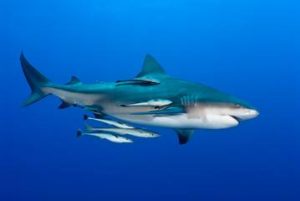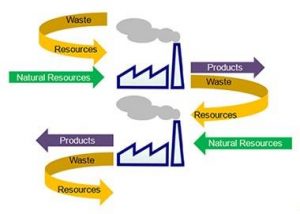Bio-fertilisers and Industrial Symbiosis
There are many cases in nature where species team up to help each other, a behaviour known as symbiosis. Resources or services that may be scarce for one organism may be cheap and easy for another to provide.
An example of such is the mutually beneficial relationship between sharks and remora fish. A not so picky eater the remora fish attaches itself the the shark. These fish also attach to whales, tuna, sea turtles and many other large sea animals. The remora fish attaches to the belly of the shark by a sucker disc in it’s mouth. It travels everywhere the shark goes. It eats any parasites on the shark which helps keep the shark clean. It also eats any leftover food from the shark. The remora (sucker fish) gets to eat and the shark stays clean and healthy.


Another example are the African oxpeckers and the giraffe. African oxpeckers (Buphagus africanus and Buphagus erythrorhynchus) feed on the backs of zebra, elephants, hippopotamuses and other large African animals. Once thought to be friendly tick-eating helpers, they’re actually vampire birds, sucking blood out of open tick-wounds. This shows how the line between symbiotic assistant and parasite can be blurred. Oxpeckers do eat ticks as well, and some animals may be happy to sacrifice a bit of blood for this service. Oxpeckers may also be tolerated because they produce a hissing scream when startled – like a personal danger alarm.
In the same vein, industrial symbiosis is the process by which wastes or by‐products of an industry or industrial process become the raw materials for another. Application of this concept allows materials to be used in a more sustainable way and contributes to the creation of a circular economy.
This is an essential tenet of bio-fertilisers, which transform what would otherwise be discarded materials from other agricultural and industrial processes – avoiding landfill by giving them a new lease of life in an innovative, safe and sustainable product.
Some examples of materials revalorised as inputs to organic-based fertilisers and soil improvers include:
 1. Spent yeasts from the beverage industry
1. Spent yeasts from the beverage industry
2. Cakes left over after oil has been extracted from plants
3. Hide scraps from leather-making
4. Manures from livestock production
5. Food wastes
Fertilisers from organic waste have a positive effect also on soil and food quality and therefore benefit the farmers as well as the consumers. Available and affordable natural fertiliser such as compost therefore fulfils an existing need. By closing the loop of organic nutrients bio-fertilisers promote also sustainable agriculture.
SYMBIOSIS project will try to close the loop on the cross border area between Greece and the Republic of North Macedonia. The project main objective is to set up an integrated, sustainable, bio-waste management and trading scheme between the partner regions of Western Macedonia in Greece and the municipality areas of Bitola and Novatsi in Republic of North Macedonia. SYMBIOSIS will develop symbiotic networks bringing together companies and stakeholders from all business sectors, aiming to improve cross industry resource efficiency through material trading and sharing assets in an environmentally sustainable way.
The benefits of industrial symbiosis are clear, but still require effort. Stakeholders must work together to optimise resource use and close material loops by recycling wastes and by-products and using them as inputs for other production processes to ensure a more circular and sustainable future for the entire cross border area.
Disclaimer
The views expressed in this publication do not necessarily reflect the views of the European Union, the participating countries and the Managing Authority.




